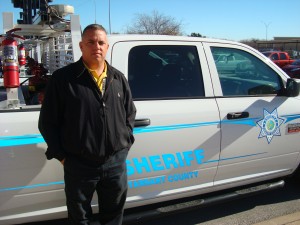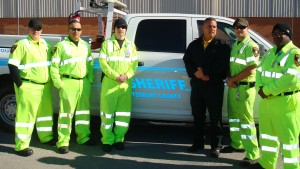Headlights on… Lynn R. Self
Current Company: Tarrant County Sheriff’s Office
Department: Courtesy Patrol
Position/Title: Program Manager
Please describe your early aspirations/career goals that led to your current role as Program Manager of the Texas Tarrant County Courtesy Patrol?
Prior to coming to the Sheriff’s Office I was a manager of regional recruiting offices for the US Navy, and later a civilian contractor for the Department of Defense. Coordinating the activities of multiple offices helped me prepare for the duties I have now.
When was the Tarrant County Courtesy Patrol implemented and what services does the Courtesy Patrol provide today on Tarrant County’s freeways?
The Courtesy Patrol was operated by TXDOT for more than 20 years before the Sheriff’s Office took over. Tarrant County Sheriff’s Office (TCSO) has been operating the Courtesy Patrol for 5 years. We provide assistance to stranded motorists to get them back on the road, assist local police agencies at the scenes of major traffic delays, clear minor debris, and look for and report any road conditions needing attention.
The Sheriff’s Office operates the Tarrant County Courtesy Patrol. What advantages (or disadvantages) are there to managing the Courtesy Patrol in collaboration with the work of the Sheriff’s department? How do the Courtesy Patrol and Sheriff’s department work together?
The chief advantage to having the Sheriff’s Office operating the courtesy patrol is that we have a common working relationship with our law enforcement partners. We understand, and are familiar with, LE operations; and we also have a traffic safety perspective from TXDOT. Though we are part of the Patrol Division of the Sheriff’s Office, virtually all of our service area is within cities patrolled by local police. Our trucks provide a visible presence of the Sheriff’s Office in areas not normally patrolled by deputies.
The Tarrant County Courtesy Patrol’s coverage areas end at the border of Tarrant and Dallas Counties. Dallas County also utilizes a Courtesy Patrol. In what ways have the two patrols worked together and how do the two managing departments communicate across county lines?
Dallas and Tarrant Counties are in different TXDOT districts. We have had the opportunity to work with Dallas County on special events in the region, like the NBA All-Star Game, and the 2011 Super Bowl. Most of the time, our jurisdictions operate independently, but both programs are willing to collaborate as needed. My cohort in Dallas County and I visit on matters of mutual concern, and we both participate in regional planning and transportation commissions.
Does the Tarrant County Sheriff’s Office have a contingency plan in place to handle natural disasters, such as tornados and droughts, that hit Fort Worth? If so, what role does the Courtesy Patrol play in the event of a natural disaster?
The Sheriff’s Office participates in the Tarrant County Emergency Operations Plan, which includes mobilizing resources from every county department. The Courtesy Patrol’s primary function would be to help maintain open roadways for the safe movement of emergency responders, and citizens who would be attempting to evacuate the affected area.
What experience does the Tarrant County Courtesy Patrol have in assisting neighboring communities who may be affected by a natural disaster? For example, when Hurricane Rita hit Sabine Pass, Texas in 2005, did the Courtesy Patrol play a role in the response and/or the recovery?
The TCSO Courtesy Patrol has not been tasked to respond outside of our primary area to assist in disaster recovery.
When hiring new drivers, what do you view as the most important qualities and skills required for a Courtesy Patrol driver?
Our operators are actually jailers that are given the opportunity to “take a break” from working confinement for a two-year rotational assignment. We focus on a strong work ethic, an excellent time and attendance record, and a desire to broaden their experience in a non-traditional work environment.
What type of training do the Courtesy Patrol drivers undergo?
New operators attend a two-week “academy” that provides training in the proper ways to change tires, provide fuel, and jump start vehicles; safe operation of Courtesy Patrol vehicles; AED and CPR training, vehicle fire fighting, and policy orientation. The key focus is on safety – not only how to not get run over, but also how to lift, avoid back injury, and how to use tools safely. You may think you know how to change a tire on the side of a busy freeway, but do you know how to do it safely?
What types of changes and improvements have been made to the Courtesy Patrol over the years to ensure safety remains the top priority?
When TCSO took over the Courtesy Patrol we designed everything from scratch. We created new ANSI Level 3 reflective and neon green uniforms in collaboration with a national garment manufacturer. We designed our trucks to carry their equipment in a logical way so that operators do not have to stretch and reach to get materials. We incorporated pull out racks so that cones, jacks, and tools can be retrieved at waist high level, rather than bending over and lifting. All materials are accessible from the rear of the truck, to avoid having to get materials from the sides. We added low profile, but powerful on-demand compressors to save space, and keep the center of gravity as low as possible. Our arrow boards are full-panel, and power-fold down when not in use (to save fuel and lower clearance). We designed our truck reflectivity and lighting scheme to be ultra-visible and unique from law enforcement vehicles, tow trucks, and even TXDOT trucks. You can spot our trucks by their lighting from a long way away, and they catch your attention.
How do you envision the program will change over the next decade?
The root purpose of our program is to keep traffic moving to help improve air quality. There will likely be changes in equipment and vehicles to provide a more “green” example. Regional collaboration will be a higher priority as the spaces between cities fill in, and political boundaries become less distinct in comparison to regional air quality solutions.
Please share an anecdote of a great assist or tale of a driver that went “above and beyond” the call of duty.
A few years ago one of our trucks came across a motorist who had experienced a mechanical breakdown of their vehicle. The motorist was a doctor who was trying to get to an area hospital to perform emergency surgery. The operators made an effort to get his car running, but it was clear that the repair was more than they could do. So, they loaded the doctor up and transported him to the hospital so that the patient could receive the surgery they desperately needed. Of course, the hospital was well off the route of the Courtesy Patrol unit, but there was no faster way to deliver him. In a way, we helped two people in that one event.
What would you like other states to know about the Tarrant County Courtesy Patrol?
Our program has a high priority on safety, and we have developed several innovations in equipment and training to provide a safe working environment. We aren’t the biggest Courtesy Patrol program, but we are good at what we do.
What would you like to know about other state’s Safety Service Patrols?
We are always interested in new techniques or innovations to make the job more effective, more efficient, and safer. Equipment or design ideas are always attention getters.
What is the one theme you would want to reinforce in Safe Highway Matters’ forum?
Safety first, last, and in the middle!

